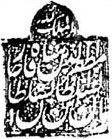| This is a Wikipedia user page. This is not an encyclopedia article or the talk page for an encyclopedia article. If you find this page on any site other than Wikipedia, you are viewing a mirror site. Be aware that the page may be outdated and that the user in whose space this page is located may have no personal affiliation with any site other than Wikipedia. The original page is located at https://en.wikipedia.org/wiki/User:HistoryofIran/Mozaffar_ad-Din_Shah_Qajar. |
| Mozaffar ad-Din Shah Qajar | |
|---|---|
 Picture of Mozaffar ad-Din Shah | |
| Shah of Iran | |
| Reign | 1 May 1896 – 3 January 1907 |
| Predecessor | Naser al-Din Shah Qajar |
| Successor | Mohammad Ali Shah Qajar |
| Prime Minister | Mirza Nasrullah Khan |
| Born | 23 March 1853 Tehran, Qajar Iran |
| Died | 3 January 1907 (aged 53) Tehran, Qajar Iran |
| Burial | |
| Spouses | Taj ol-Molouk |
| Issue | See below |
| Dynasty | Qajar |
| Father | Naser al-Din Shah |
| Mother | Shokouh al-Saltaneh |
| Religion | Twelver Shia Islam |
| Tughra |  |
Mozaffar ad-Din Shah Qajar (Persian: مظفرالدین شاه قاجار, romanized: Mozaffar ad-Din Ŝāh-e Qājār; 25 March 1853 – 3 January 1907) was the fifth Qajar shah (king) of Iran, reigning from 1896 until his death in 1907.
Biography
editMozaffar ad-Din was on 25 March 1853 in the capital of Tehran. He was the fourth son of the Qajar shah (king) of Iran, Naser al-Din Shah Qajar (r. 1848–1896). His mother was Shokouh al-Saltaneh, a daughter of Fath-Ali Mirza and a granddaughter of the second Qajar shah Fath-Ali Shah Qajar (r. 1797–1834).[1] Prior to Mozaffar ad-Din, two of Naser al-Din Shah's elder sons were named vali ahd (heir apparent); Soltan Moin ed-Din Mirza was the first to be named in 1849. However, he died as a child on 6 November 1856, and thus Mohammad-Qasem Mirza was appointed the new vali ahd. He also died as a child, on 29 June 1858.[1]
Naser al-Din Shah, dubbed the "Martyr King," was lamented in the Iranian government-sponsored Shia passion plays, but Mozaffar ad-Din Shah's inner circle could barely contain their joy, having long harbored the hope of financial gain. Nevertheless, they soon discovered that the state treasuries were almost completely empty.[2]
Personality and health
editThe responsibilities of leading such a dysfunctional and possibly unstable nation were not suitable for Mozaffar ad-Din Shah's character and demeanor. He was hesitant, introverted, erratic, as well sentimental and prone to superstition. His "nervous disposition" was described by several people who knew him well. Mozaffar ad-Din Shah had hypochondria due to having health issues since he was young. He had a number of illnesses, including a weak heart, but his most severe problem was a chronic kidney infection. Despite this, he enjoyed riding, hunting, and shooting, just as many of his ancestors.[1]
According to the modern Iranian historian Abbas Amanat, Mozaffar ad-Din Shah "possessed neither his father’s panache nor his political skills to pull strings at the court and the divan, or to play the competing European powers off one another to his own advantage. He was a man of gentle disposition, with an earnest desire to open up the country to social and educational reforms."[3] The British diplomat Mortimer Durand, who was well-acquainted with both shahs, wrote that Mozaffar ad-Din Shah "is more amiable than his father but he is weak and easily misled.[4]
References
edit- ^ a b c Burrell 1993.
- ^ Amanat 1997, p. 199.
- ^ Amanat 2017, p. 323.
- ^ Burrell 1979, p. 24.
Sources
edit- Amanat, Abbas (1997). Pivot of the Universe: Nasir Al-Din Shah Qajar and the Iranian Monarchy, 1831–1896. I.B.Tauris. ISBN 978-1845118280.
- Amanat, Abbas (2017). Iran: A Modern History. Yale University Press. ISBN 978-0-300-11254-2.
- Burrell, Robert Michael (1979). Aspects of the Reign of Muzaffar al-Din Shah of Persia: 1896–1907. University of London.
- Burrell, Robert Michael (1993). "Muẓaffar al-Dīn S̲h̲āh Kad̲j̲ār". In Bosworth, C. E.; van Donzel, E.; Heinrichs, W. P. & Pellat, Ch. (eds.). The Encyclopaedia of Islam, Second Edition. Volume VII: Mif–Naz. Leiden: E. J. Brill. ISBN 978-90-04-09419-2.